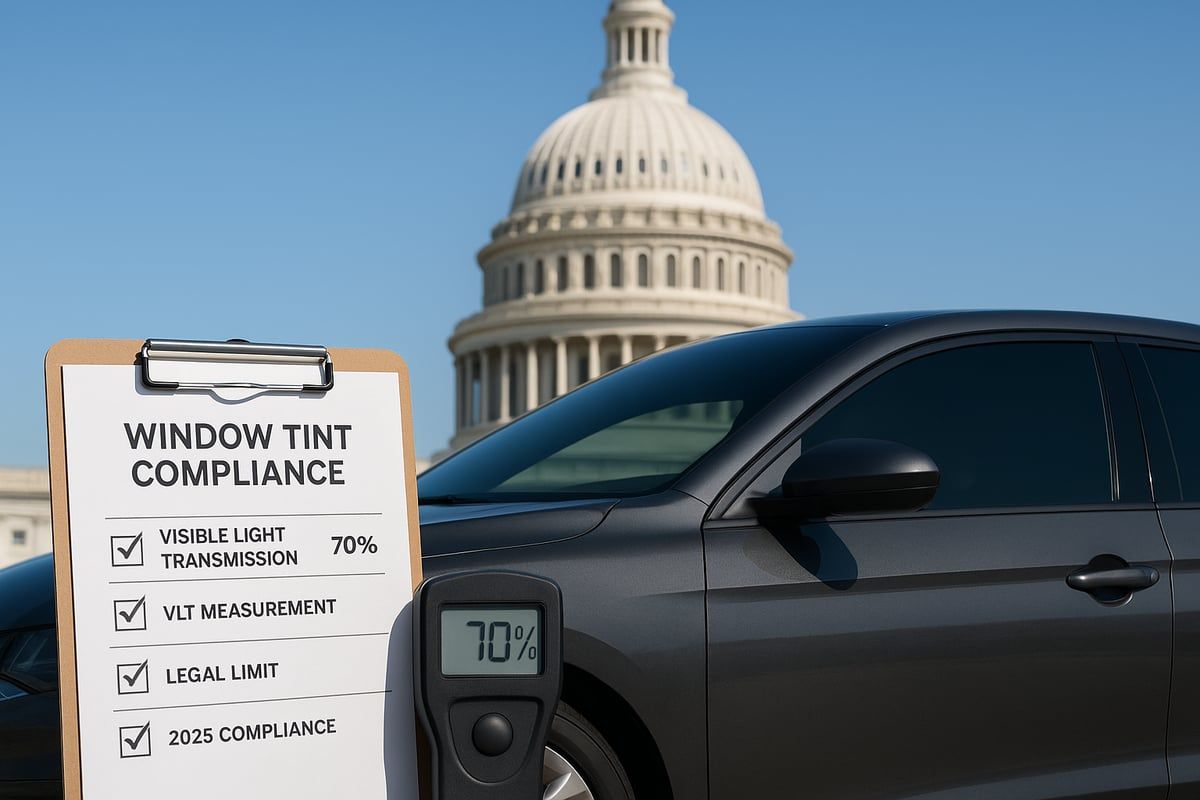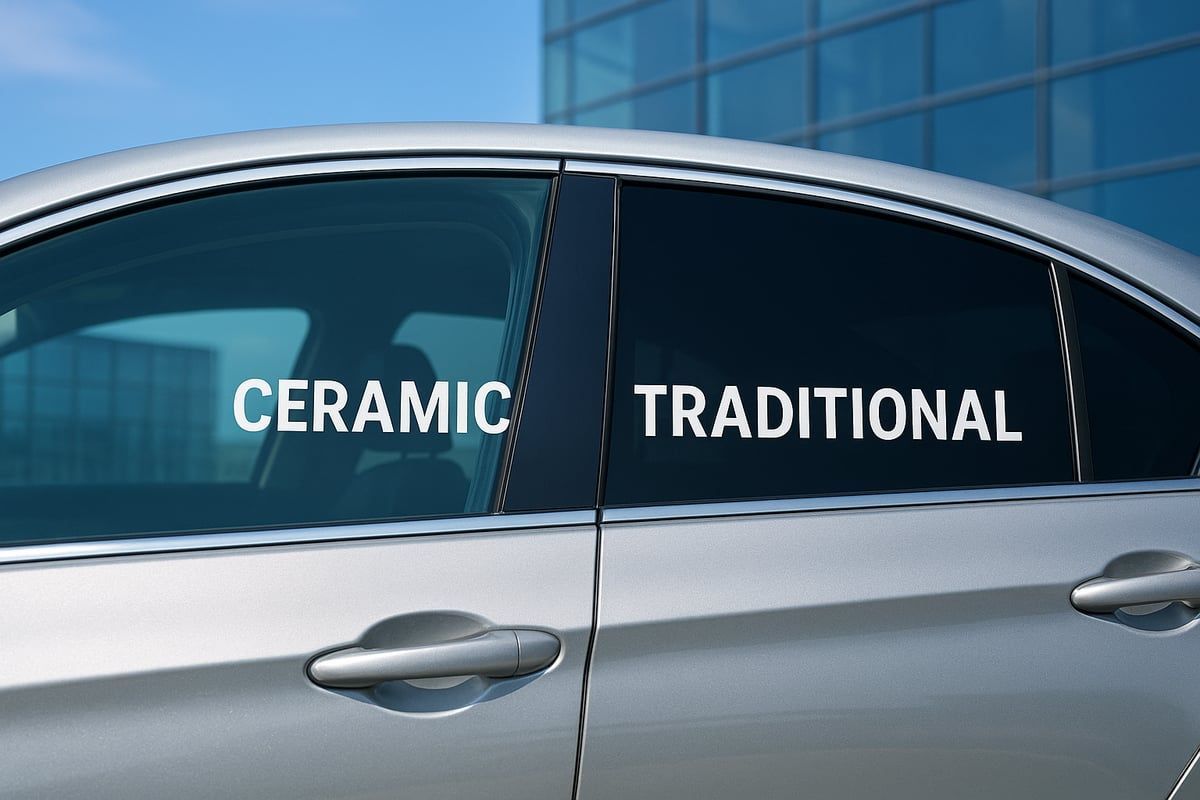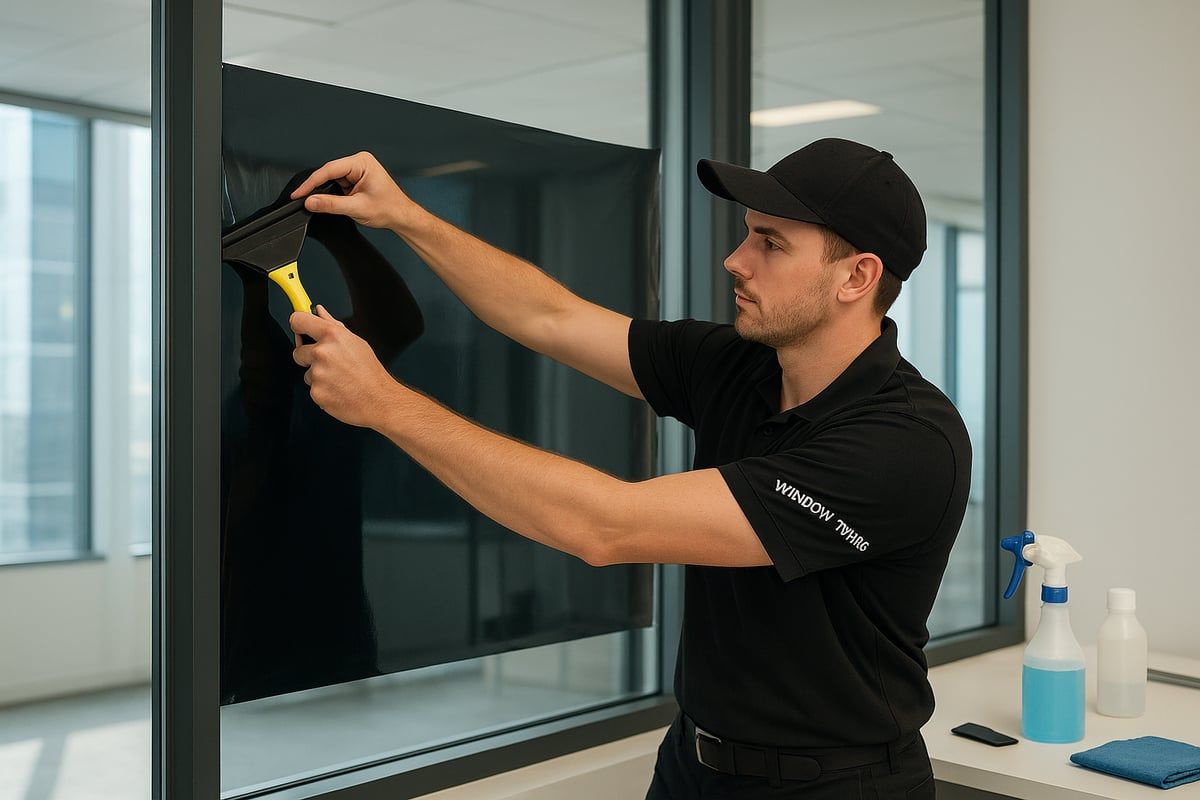Ballistic Film Guide: Protect Windows With Advanced Security 2025
Ballistic Film Guide: Protect Windows With Advanced Security 2025
Property threats and security breaches are making headlines more often, pushing the need for advanced window protection to the forefront. Traditional glass leaves homes, businesses, and schools exposed to forced entry, vandalism, and even ballistic threats.
In 2025, many are turning to ballistic film as a cutting-edge defense. This innovative technology enhances window security without the expense or disruption of installing bullet-resistant glass.
This comprehensive guide explains what ballistic film is, how it works, its advantages and drawbacks, installation best practices, and how to choose the right option for your safety needs.
Understanding Ballistic Film: What It Is and What It Isn’t
Ballistic film has become a focal point in the conversation about modern window security, especially as property owners seek practical, effective defenses. Understanding exactly what ballistic film is—and what it is not—is crucial for making informed decisions about building safety upgrades.
Defining Ballistic Film and Security Window Film
Ballistic film is a type of security window film designed to enhance the strength and resilience of glass against severe impacts. Unlike standard window films, which primarily address UV protection or privacy, ballistic film is engineered for security, using thick polyester laminates and advanced adhesives.
A common misconception is that all security films offer similar protection. In reality, there are important distinctions:
- Ballistic film: Increases resistance to forced entry and blast events, but does not stop bullets.
- Security window film: Offers protection against break-ins and accidents, but may have less robust construction.
- Bulletproof film: Often a misused term; no film alone can make glass bulletproof.
Industry leaders such as RiotLite and C-Bond BRS use multi-layered polyester and proprietary adhesives to maximize forced-entry resistance. As of 2025, no ballistic film has achieved a UL 752 rating, which remains exclusive to bullet-resistant glass. This distinction is vital for organizations evaluating glazing upgrades.
Ballistic film is often chosen for schools, commercial properties, and government buildings seeking a retrofit solution that provides significant delay against intrusion without the high cost or disruption of full glass replacement. For a deeper look at these distinctions and security film options, see this Safety and Security Window Film resource.
How Ballistic Film Works to Protect Windows
The core function of ballistic film is to hold glass fragments together after an impact, whether from a blunt object, tool, or even a blast event. When applied correctly, the film forms a tough, flexible layer on the glass, preventing it from shattering and falling apart immediately.
This mechanism provides crucial benefits: it delays forced entry attempts, buys time for occupants to respond or escape, and reduces the risk of injury from flying glass shards. In active shooter scenarios, for example, ballistic film can slow down intruders, giving law enforcement or security teams precious extra minutes. Retailers use it to deter smash-and-grab theft, as the film makes quick access much more difficult.
However, the effectiveness of ballistic film depends on factors like the underlying glass quality, the method of installation, and whether the edges are properly anchored to the window frame. If not installed professionally, the film’s performance can be significantly compromised.
Myths and Facts About Ballistic Film Performance
Despite marketing claims, ballistic film is not bulletproof and should not be relied upon to stop gunfire. Some promotional materials blur the line between forced-entry resistance and true ballistic protection, leading to confusion among property owners.
Documented testing shows that while ballistic film can dramatically increase the time it takes to breach a window and mitigate blast effects, it is not a substitute for certified bullet-resistant glass. Its main strengths lie in delaying intrusions and holding glass together after violent impacts.
Understanding the real capabilities of ballistic film—separating facts from myths—is essential for building a security strategy that matches your actual risk profile.
Benefits and Limitations of Ballistic Film in 2025
The rising popularity of ballistic film is transforming window security for property owners in 2025. This advanced material offers a unique blend of protection, affordability, and adaptability that is reshaping how businesses, schools, and institutions think about glazing security.
Key Security Benefits
Ballistic film provides forced-entry resistance that is highly valued in security planning. When applied to windows, it holds shattered glass together after impact, making it significantly harder for intruders to gain quick access. This delay can deter opportunistic crimes and provide critical time for law enforcement or security teams to respond.
Another important benefit is injury reduction. By keeping broken glass in place, ballistic film reduces the risk of flying shards that can cause severe injuries during break-ins or blasts. The versatility of ballistic film is also notable. It can be retrofitted to most existing windows with minimal visual impact, making it a cost-effective alternative to installing new security glazing.
For organizations looking to boost security without major renovations, ballistic film offers a practical solution. It can be installed quickly, often with little disruption to daily operations. For a deeper dive into the types and uses of security films, the Expert Guide to Security Film provides valuable insights.
Limitations and Considerations
While ballistic film enhances security, it is not a substitute for bullet-resistant glass. The material does not stop bullets, and its performance relies heavily on the quality of the glass substrate and the skill of the installer. Proper anchoring to window frames is essential for maximum effectiveness.
Currently, no ballistic film holds a UL 752 rating, which is the industry standard for bullet-resistant materials. This fact is confirmed by leading manufacturers and security consultants. Longevity is another consideration. Over time, exposure to UV rays and environmental conditions may lead to delamination or reduced clarity, requiring periodic inspection and maintenance.
Ballistic film should not be the sole defense for high-risk entry points. It excels as a forced-entry deterrent and injury mitigator but should be part of a broader, layered security strategy, especially in environments facing elevated threats.
Data and Real-World Examples
The real-world impact of ballistic film is supported by data and case studies. Schools have adopted solutions like RiotLite to enhance safety in active shooter scenarios, using the film to slow down intrusions and protect occupants. Retail storefronts have reported reductions in smash-and-grab incidents after installing ballistic film.
According to Impact Security, ballistic film can delay forced entry by 60 seconds or more, buying valuable time for emergency response. This delay can be the difference between a minor incident and a major loss.
Security SolutionAverage Forced Entry DelayApproximate Cost per Sq FtVisual ImpactBallistic Film60+ seconds$15-$25MinimalBallistic Glass5+ minutes (gunfire)$125-$200Moderate
The cost advantage of ballistic film makes it accessible to a wider range of organizations. While it does not provide bullet stoppage, its ability to reinforce existing windows and extend response times is a compelling reason for its growing adoption in 2025.
Ballistic Film vs. Bullet-Resistant Glass: Making the Right Choice
When it comes to window security, choosing between ballistic film and bullet-resistant glass can feel daunting. Both options enhance protection, but each serves a distinct purpose. Understanding their differences is crucial for making the right decision.
Performance Comparison
Ballistic film and bullet-resistant glass address different threats. Ballistic film is engineered to reinforce existing glass, holding shards in place after impact and delaying forced entry. This buys valuable response time during break-ins or active threats. However, ballistic film is not designed to stop bullets. In contrast, bullet-resistant glass is built to absorb and disperse ballistic energy, preventing projectiles from penetrating.
To clarify, no ballistic film on the market carries a UL 752 rating for bullet stoppage. Bullet-resistant glass meets these rigorous standards and is preferred where direct gunfire protection is needed. In real-world scenarios, schools and businesses have used ballistic film to deter intruders and slow down attacks, as highlighted in the Ballistic Witness – School Safety Video, which demonstrates its effectiveness in forced-entry delays.
FeatureBallistic FilmBullet-Resistant GlassBullet StoppageNoYesForced-Entry DelayYesYesRetrofits Existing GlassYesNoVisual ImpactMinimalModerate
Choosing between these options depends on whether your primary concern is delaying entry or stopping bullets.
Cost, Installation, and Maintenance
The installation process for ballistic film is straightforward. It can be retrofitted to existing windows, resulting in minimal disruption and lower upfront costs. This makes it accessible for many organizations seeking enhanced security without major renovations.
On the other hand, bullet-resistant glass requires full window replacement. This involves significant labor, higher material costs, and often longer lead times. While bullet-resistant glass is more durable, repairs are expensive if damage occurs.
Maintenance requirements differ as well. Ballistic film may need replacement every 5 to 10 years due to potential delamination or UV exposure. Bullet-resistant glass is built to last, though any repairs are more complex and costly. Both solutions benefit from routine inspections to ensure ongoing effectiveness.
Strategic Layering for Maximum Security
For maximum protection, many security experts recommend a layered approach. Combining ballistic film with bullet-resistant glass can create a formidable barrier against both forced entry and ballistic threats.
Organizations often prioritize bullet-resistant glass at the most vulnerable entry points, such as main doors or reception areas. Ballistic film is then applied to secondary glazing or less critical windows, providing widespread forced-entry resistance without the expense of full glass replacement.
This strategy allows property owners to balance budget constraints with security needs. It also offers flexibility, enabling upgrades as risks evolve or as resources allow. Consultation with security professionals ensures that each layer is placed where it will have the greatest impact.
Regulatory and Insurance Considerations
Selecting the right solution also involves compliance with local building codes and insurance requirements. Some jurisdictions may specify minimum standards for window security, especially in schools or government facilities.
Insurance providers increasingly recognize the value of ballistic film and bullet-resistant glass. Enhanced window security can result in premium reductions or even be mandated for certain types of coverage. When planning upgrades, property owners should consult insurers and regulatory bodies to ensure all requirements are met.
Proper documentation of installation and product specifications is essential. This not only supports compliance but also assists in future claims or audits. Staying informed about evolving standards will help organizations maintain both safety and regulatory alignment.
The Installation Process: Ensuring Maximum Protection
Proper installation is the key to unlocking the full benefits of ballistic film. Even the most advanced security film will underperform if not expertly installed. Let’s break down the entire process, from choosing the right installer to ensuring your windows stay protected for years.
Professional vs. DIY Installation
When it comes to ballistic film, professional installation is not just recommended, it is essential. While some may consider a DIY approach, improper installation can compromise the film’s performance and void warranties. Certified installers ensure the film is anchored correctly, especially at the edges, maximizing forced-entry resistance.
A professional will assess the site, select the right product, and follow best practices for application. For a deeper understanding of expert techniques and why they matter, review this Window Tinting Professional Guide. This resource highlights how precision and experience impact the effectiveness of ballistic film.
Key Installation Steps (Chronological)
Every successful ballistic film installation follows a precise sequence:
- Step 1: Conduct a thorough security assessment and select the appropriate product.
- Step 2: Measure each window and prepare surfaces by cleaning and degreasing.
- Step 3: Carefully cut the film to size and apply the adhesive layer to the glass.
- Step 4: Mechanically anchor the film to the window frames for structural integrity.
- Step 5: Allow the film to cure, then inspect for bubbles, defects, or lifting edges.
Each step is vital. If the film is not anchored properly, its ability to hold shattered glass together is diminished. The right installation method ensures ballistic film delivers the intended level of protection.
Maintenance and Longevity
Ballistic film typically lasts between five and ten years, depending on exposure and product quality. Routine maintenance keeps the film clear and effective. Clean windows with non-abrasive solutions and soft cloths to prevent scratches or peeling.
Regular inspections are important. Look for signs of delamination, bubbling, or discoloration. If you notice any of these issues, it may be time to replace the film. Proper care ensures your ballistic film remains reliable over time.
Choosing a Qualified Installer
Selecting a trusted installer is crucial for maximizing the benefits of ballistic film. Look for professionals with manufacturer certifications and a proven track record in security film projects.
Ask the following questions:
- Which brands and products do you use?
- Can you provide references from similar installations?
- What warranties are offered on both labor and materials?
A qualified installer will offer transparent answers and stand behind their work, giving you confidence in your window security investment.
Lewolf Window Tint and Film Solutions: Expert Ballistic Film Installation
Lewolf Window Tint and Film Solutions specializes in ballistic film for schools, businesses, and organizations nationwide. Their team uses advanced systems like C-Bond BRS to enhance forced-entry resistance and protect occupants.
Lewolf’s installation process includes site assessments, detailed prep, expert film application, and mechanical anchoring for maximum performance. All work is backed by warranties, ensuring peace of mind. Their experience with diverse property types and commitment to quality make them a top choice for ballistic film solutions. Contact Lewolf for a consultation or free estimate, and take the first step toward stronger window security.
Selecting the Right Ballistic Film Solution for Your Needs
Choosing the right ballistic film solution starts with a clear understanding of your unique security needs. Every building, whether a school, business, or government facility, faces different threats and vulnerabilities. A tailored approach ensures you maximize protection and value.
Assessing Your Security Risks and Objectives
Begin by conducting a thorough risk assessment of your property. Consider factors such as location, local crime rates, and recent incidents in your area. Identify potential threats, including forced entry, vandalism, or ballistic events, and determine which windows or glass doors are most vulnerable.
Decide on your primary objectives for ballistic film. Are you aiming to deter break-ins, enhance safety during emergencies, or meet insurance requirements? Clarifying your goals will help narrow down the options and ensure the chosen solution addresses your specific needs.
Evaluating Product Options
Once you know your requirements, evaluate the available ballistic film products on the market. Pay close attention to film thickness, as multi-layer constructions can offer greater resistance to impact. Some products, like those up to 41 mils thick, offer enhanced performance for high-risk settings.
Compatibility with your existing glass and frames is also crucial. Assess whether the film can be retrofitted easily or if additional modifications are needed. Consider the transparency, tint, and overall appearance, especially if you want to maintain the building’s aesthetics. For a deeper dive into technical performance and safety considerations, review the EWFA Technical Paper on Safety Films.
Comparing Leading Ballistic Film Brands and Technologies
Not all ballistic film brands are created equal. Leading manufacturers, such as RiotLite and C-Bond BRS, offer varying features, certifications, and performance data. Compare forced-entry delay times, blast resistance, and impact performance when reviewing products.
Look for independent third-party testing and any available certifications. For practical product comparisons and insights into the best solutions for 2025, check out the 9 Best Window Tint Film Choices for 2025. This resource highlights top film options, including those designed for security and ballistic threats.
Brand/TechnologyThickness (mils)Forced-Entry DelayBlast ResistanceCertificationsRiotLiteUp to 4160+ secondsYes3rd-partyC-Bond BRSVaries60+ secondsYes3rd-party
Working With Security Professionals
Partnering with experienced security professionals is essential for selecting and installing ballistic film. Experts can assess your property, recommend products based on real-world threats, and ensure proper placement for maximum coverage.
Ask about their experience with similar projects, manufacturer certifications, and whether they provide references. A qualified installer will handle site assessments, product selection, and warranty-backed installation for long-term peace of mind.
Budgeting and Return on Investment
Balancing your security needs with available resources is key. Ballistic film delivers significant value, offering a cost-effective upgrade compared to full window replacement with bullet-resistant glass. In many cases, it also qualifies for insurance premium reductions and can enhance property value.
Consider both the upfront cost and long-term benefits. While installation represents an initial investment, the extended delay time during an attempted intrusion and the reduction in glass-related injuries can deliver substantial returns over time.
Future Trends in Window Security: Innovations and Predictions for 2025
The window security landscape is rapidly evolving as threats become more sophisticated and property owners demand stronger solutions. In 2025, ballistic film is at the center of innovation, pushing the boundaries of what protective glazing can achieve. Let us explore the key trends driving the future of this technology.
Advancements in Ballistic Film Technology
Ballistic film manufacturers are investing in advanced polymers and adhesives to improve protection and durability. New research into polymer chain configurations, such as star topology, is enhancing the ballistic resistance of thin films. These material innovations allow for films that are stronger, more flexible, and compatible with smart glass systems and integrated alarms.
Looking ahead, expect ballistic film to become more effective at holding glass together under extreme impact. The integration with building automation and security systems will also enable real-time threat detection and response, making window protection smarter and more reliable.
Regulatory Developments and Standards
As adoption of ballistic film grows, regulatory bodies are updating building codes and compliance requirements. In 2025, expect more clarity around testing standards for ballistic film, especially as demand increases in schools and public facilities. While no UL 752 rating currently exists for ballistic film, industry stakeholders are advocating for new, film-specific standards to measure forced-entry and blast resistance.
Property owners should stay informed about local regulations and ensure any window security upgrades meet or exceed the latest requirements. These developments will shape how ballistic film solutions are specified, installed, and maintained across sectors.
Market Growth and Adoption
The market for ballistic film is expanding, with strong demand from education, retail, and public agencies. According to Bulletproof Glass Market Analysis by Mordor Intelligence, the security glazing industry, including ballistic film, is projected to experience significant growth in 2025 and beyond. Factors such as increased awareness of active shooter threats and rising property crime rates are driving this trend.
Schools and businesses are prioritizing cost-effective solutions that can be retrofitted to existing windows. As a result, ballistic film is becoming a preferred choice for organizations seeking enhanced security without the disruption and expense of full window replacement.
Emerging Threats and Security Needs
Criminal tactics are constantly evolving, which puts new pressure on window security strategies. Ballistic film plays a vital role in comprehensive security plans by delaying forced entry and reducing injury from shattered glass. As threats shift toward coordinated attacks or more powerful tools, property owners must assess their vulnerabilities and adopt multi-layered defenses.
By staying proactive, organizations can adapt to changing risks and ensure their window security remains effective against both current and emerging threats.
Expert Recommendations for Staying Ahead
To maximize protection in 2025, experts recommend a layered approach that combines ballistic film with other physical and electronic measures. Conduct regular training and drills so staff know how to respond during an incident. Stay current on product advancements, certifications, and best practices by consulting with security professionals.
Continuous evaluation and adaptation will keep your property ahead of threats and ensure your investment in ballistic film delivers lasting value.
As we’ve explored, safeguarding your windows is more crucial than ever with today’s security challenges. Ballistic film offers a smart, effective way to strengthen your property without the need for expensive renovations or major disruptions. Whether you’re protecting a school, business, or public space, having the right solution in place can mean the difference between vulnerability and peace of mind. If you’re ready to take the next step toward advanced protection and want expert advice tailored to your needs, I encourage you to Get Protected Today.










